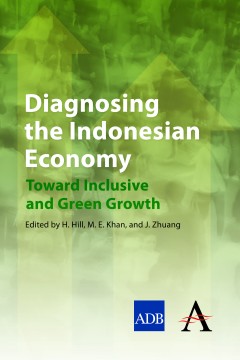Diagnosing the Indonesian Economy
Toward Inclusive and Green Growth
Edited by Hal Hill
Muhammad Ehsan Khan
Juzhong Zhuang
- About This Book
- Reviews
- Author Information
- Series
- Table of Contents
- Links
- Podcasts
About This Book
‘Diagnosing the Indonesian Economy: Toward Inclusive and Green Growth’ commences with a broad overview of Indonesia’s development since the 1960s. The analytical frameworks for the study, which were developed at Harvard University and ADB, are then used in an attempt to identify the constraints that most severely bind the country’s development, and therefore the priorities for policy implementation and/or reform. The country’s macroeconomic management and monetary policy since the Asian financial crisis is reviewed. The challenges of Indonesia’s slow industrial transformation and small industry sector are described, as are their implications for poverty reduction efforts. The challenges Indonesia faces in developing its infrastructure are set out, e.g., the country’s diverse topography, archipelagic nature, and monopolies. Human capital, an essential element in both growth and poverty reduction, is analyzed for the country, including the improvements in enrolments and gender balance, and the limitations the poor face to accessing education. Indonesia’s record on poverty reduction is traced, as are the efforts to improve it. The links between employment creation and poverty reduction are presented, with a focus on the pressing issue of youth employment. The impact and status of the decentralization effort and efforts to fine-tune it are discussed. Last, the rather dismal status of the country’s environment and natural resources management and the emerging impacts of climate change are summed up.
Indonesia’s national development plan for 2005–2025 sets a vision of a country that is self-reliant, has a highly educated population with capable human resources, has no discrimination, and is prosperous enough to fulfil its population’s needs. This will require high levels of economic growth that is both socially inclusive and environmentally sustainable. The volume identifies that in order to overcome the binding constraints to this growth, Indonesia needs to improve its infrastructure, enhance the education system to provide a more capable workforce, revive its manufacturing sector to open up employment, and facilitate these efforts through substantially improved governance and institutions. Furthermore, this growth must be accomplished in a manner that is harmonious and not destructive to the environment and natural resource base.
Reviews
‘[Aimed] at students, academics, journalists and business people who are new to Indonesia, and need a handy one-volume compendium on the main features of the economy, and the key policy debates.’ —Anne Booth, SOAS, University of London, in ‘Aseasuk News’
‘A great piece of collaborative work among Indonesia’s development partners and national think-tanks to identify the critical constraints to the country’s economic growth, poverty reduction, and to create and equitable regional development in Indonesia. [This book] is a valuable reference for policy-makers, academics, students, and the general public who are interested in Indonesian economic policy.’ —Siwage Dharma Negara, ‘Journal of Southeast Asian Economies’
Author Information
Hal Hill is the H.W. Arndt Professor of Southeast Asian Economies at the Australian National University. His general research areas are the ASEAN economies, especially Indonesia and the Philippines; industrialization and foreign investment in East Asia; and Australia’s economic relations with the Asia and Pacific region.
Muhammad Ehsan Khan is a Principal Economist in the Economics and Research Department at the Asian Development Bank (ADB) and has served as a Project Economist in ADB’s Southeast Asia Department. He is leading ADB’s work in the area of development diagnostics.
Juzhong Zhuang is the Deputy Chief Economist in ADB’s Economics and Research Department. He has served as a Principal Economist and Senior Economist in ADB’s Office of Regional Economic Integration.
Series
The Anthem-Asian Development Bank Series
Anthem Southeast Asian Studies
Table of Contents
Foreword – Changyong Rhee; Preface; Author Profiles; Abbreviations and Acronyms; 1. Introduction – Hal Hill, Muhammad Ehsan Khan, and Juzhong Zhuang; 2. Development Policies and Performance – Hal Hill and Maria Rowena M. Cham; 3. Critical Constraints to Growth – Muhammad Ehsan Khan, Juzhong Zhuang, Maria Rowena M. Cham, Niny Khor, and Imelda Maidir; 4. Critical Constraints to Reducing Poverty and Inequality – Yoko Niimi and Kazutoshi Chatani; 5. Macroeconomic Management – Edimon Ginting and Priasto Aji; 6. Industrialization: Patterns, Issues, and Constraints – Haryo Aswicahyono, Hal Hill, and Dionisius Narjoko; 7. Infrastructure Development: Challenges and the Way Forward – Areef Suleman and Zafar Iqbal; 8. Human Capital and Economic Development – Kazutoshi Chatani; 9. Economic Growth, Employment Creation, and Poverty Alleviation – Kazutoshi Chatani; 10. Poverty Reduction: The Track Record and Way Forward – Asep Suryahadi, Athia Yumna, Umbu Reku Raya, and Deswanto Marbun; 11. Decentralization – Tariq Niazi; 12. Making Indonesia’s Growth Green and Resilient – Suphachol Suphachalasai, Juzhong Zhuang, Jindra Nuella Samson, Rizaldi Boer, and Chris Hope; Index
Links
Stay Updated
Information
Latest Tweets



